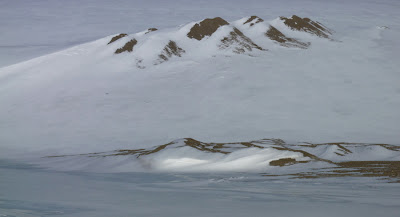This post is for my nieces and nephews in South Africa and the UK - Mikey, Tess, Phil, Tor-tor and Jonathan - and for all you young at heart.
Today has been a great work day. Five of us spent the afternoon in or around the dive hole at Herbertson Glacier. Believe me, the water is a whole lot colder here than any winter time swimming pool in SA or the UK could ever get; today it was -1.98 degrees Celsius. I've been told that if a person were to stay in that water unprotected by layers of thermal underwear and heavy-weight dry suits, it would only be a matter of minutes before he/she would turn into a human popsicle. Ouch. Sounds pretty horrible to me!
We take turns tending the divers (i.e we help them get their suits, tanks, weight belts, goggles and gloves on, then help them in and out of the water with science equipment, sediment traps, cores and experimental arrays) and I must admit that my hands don't enjoy getting wet one bit. Of course, the minute they get wet, they get cold, and once they're cold, it can be a pain (literally) trying to warm them up again. I'm becoming an expert at Jumping Jacks, pogo dancing and hopping-and-shaking on the ice! It's important we wear crampons (sometimes called 'stabilizers') around the dive hole as it can get very slippery with all the activity going on around it and there's no way you'd want to fall in.
Here's a picture of one my neon green crampons; it sproinged off my boot and landed on the ice in this quirky bird shape -

Anyway, I was thinking about the five of you this afternoon. And while I was thinking, I was chewing on a question. In Antarctica, there are only two main aquatic mammals - seals and whales. Terrestrial fauna on the continent consists entirely of invertebrates, most of them microscopic (like the aquatic foraminifera Sam studies) that live in the soil and very minimal vegetation (moss and grass can be found on the Antarctic Peninsula.). Certainly, there's zero chance you'll come across a rat, an ant, a cat, a giraffe, a wombat or an aardvark anywhere out here. Why then are so many of the things we do, see, use or wear down here, given animal names? Perhaps you can tell me why we wear bunny boots, for instance? Or neck gaters (short for 'alligators')? Why do we say glaciers calve? Why do we warm our hands inside super-insulated bear paw mitts? Why is the spare air cylinder on the divers' down-line called a pony bottle? And how did Sun Dogs get their name?
I'm attaching a few pics of the things I've just mentioned - when you have a bit of spare time, perhaps you can do a bit of research into how they got their names? I'll add another line or two to these photographs to help start you off.
You've already seen what bunny boots look like, so I'll skip those and introduce you to me and my 2005 neck gater. (I shudder to think what I would have looked like the morning this picture was taken, had I not been wearing my gater!) The good thing about gaters is that they keep your neck warm and you can pull them right up over your ears and nose when it's really cold. The not-so-good thing is that if you do that, you fog up your glasses and can't see where you're going (and you have to wear dark glasses and sunblock every time you step outside, no matter what time of day or night it is)! I mostly wear mine around my neck, but cover my mouth & cheeks with it when driving the skidoo.

This next photograph shows the Canada Glacier calving. Why do we say calving instead of using a word like 'carving' or 'sloughing' or 'fracturing'?
In this pic, I've got my hands tucked up warmly in a pair of bear paws - perhaps this style of mitt originated in a cold Northern hemisphere country like Alaska, Greenland or the Arctic where bears are plentiful? It would be impossible for a bear to arrive - let alone survive - in Antarctica, of course.
Here's a pic of a pony bottle (the team had a chuckle when I accidentally called it a 'donkey' bottle a while back! But, I ask you, how much odder would that be than its current name? No one here knows how it got its name, either - maybe you can teach us all something?!)
Last, but not least, a photograph I took about a week ago of a polar atmospheric phenomenon called a Sun Dog. The dictionary defines this as 'a bright spot in the sky appearing on either side of the sun, formed by refraction of sunlight through ice crystals high in the earth's atmosphere.' Yes, that's all very well and good, but why do we then give it the name Sun Dog?
Any bright ideas? I'm sure you'll have heaps! Let's see if we can get to the bottom of some of these things, shall we?
Final bow from this little Adele penguin who waddled up to our dive hole this afternoon.



















































